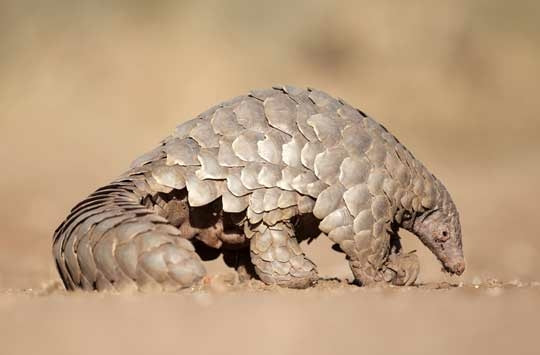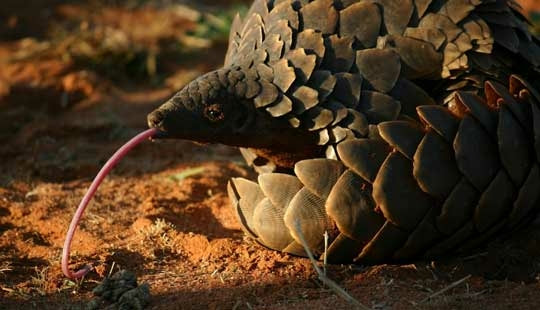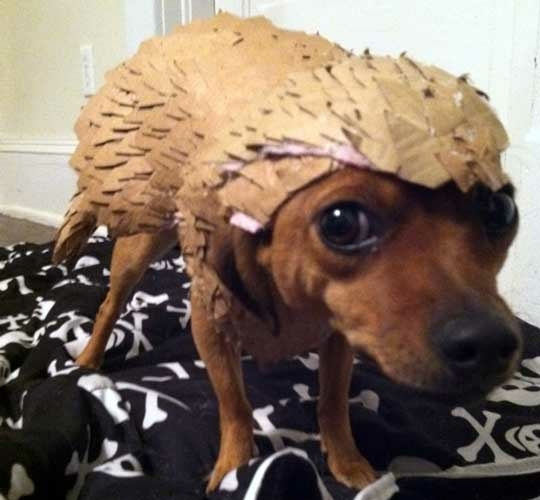|
The pangolin is a strange mammal. Considering how bizarre it is, you'd think it would be more widely recognized. But I've discovered many people have never seen a picture of one, and even fewer would recognize the name Pangolin. I'm a sucker for the really weird creatures, so I'm excited to share this one with you. So, what the heck is a Pangolin? Pronounced pang-guh-lin. Pangolins are also called scaly anteaters. They are mammals in the family, Manidae. There are currently eight species, but we know of a number of extinct species. They are found in some areas of Asia and the southern half of Africa. Pangolins have the distinct honor of being the only mammals with large scales for protection. Amazing facts about the Pangolin So what's up with those scales? A pangolin's scales are made of a protein called keratin, which is the same stuff that makes up human fingernails and hair. Keratin is also what makes up feathers, horns, hooves, and claws. So keratin is useful stuff! Pangolin scales are very different from the scales of reptiles, both in structure and composition. The scales provide protection from predators. When attacked, a pangolin will roll into a ball and tuck its vulnerable head under its heavily-armored tail. In this position, they are nearly indestructible. Not even a lion can chew through the armor! The scales make up about 20% of the animal's body weight. By the way, the underside of a pangolin is not covered in scales. Instead, it is supple skin with a few sparse hairs. So it's a good thing they can roll into a ball. Pangolins have no teeth. Yep, that's right. In this respect, they are like anteaters and armadillos (although they are not closely related to either). Pangolins feed mostly on ants and termites. They have an extremely long, sticky tongue (sixteen inches long, which is sometimes longer than the pangolin's body... wow!), with which they slurp up insects at an amazing rate. They can eat 200 grams of bugs per night, which adds up to 70 million ants and termites per year! Obviously, they are important regulators of ant and termite populations in the areas where they live. Check out this pangolin's tongue: And take a look at this 11-second video of a pangolin sticking its tongue out! The tongue is coated with sticky saliva. A pangolin can shove its tongue deep into the tunnels of ant and termite nests, and when it pulls the tongue back out, it's covered with yummy, juicy bugs. To help pangolins find all these ants and termites, they have long, sharp claws on their front feet for digging into the insects' mounds. They also use their claws to pull the bark from logs and trees to find ants and termites. In fact, they have prehensile tails, and they can hang upside down from a branch as they pull the bark from the tree's trunk. Okay, if pangolins don't have teeth, how do they chew up all those ants and termites? While they are foraging, they swallow small pebbles. These pebbles go into a portion of their stomach called the gizzard. When the insect prey are swallowed and enter the muscular gizzard, the stones chew up the insects before the insects move on to the rest of the stomach. As you may know, birds also have gizzards since they don't have teeth. Pangolins live most of their lives alone, getting together to mate only once per year. Most of the species give birth to only one baby. When the baby is born, its scales are soft (no doubt to make the birth easier on the mother!), but soon they harden and look like those of the adults. As the babies mature, they often ride around on the mother's back or on the top of her tail. Unfortunately, the pangolin has the dubious distinction of being the Most Illegally Traded Mammal In The World. Since 2006, over a million pangolins have been taken from the wild to meet the demand for their scales and their meat (particularly in East Asia and parts of Africa). Their scales are considered essential for making some traditional medicines (but there is no evidence that any part of a pangolin has a beneficial effect on humans), and their meat is considered a delicacy. But... things are looking better. In 2016, the Convention on International Trade in Endangered Species (CITES) passed a motion to move pangolins to Appendix I – offering all eight species of pangolin from both Asia and Africa the highest levels of protection, making trade in their parts completely illegal. This, and some aggressive public awareness campaigns should give these unique creature a better chance of surviving extinction. You REALLY need to see this video! This is an ad from WildAid, to help make people aware of the plight of the pangolin and the new regulations banning the trade of pangolin products. It stars the awesome movie star, Jackie Chan. One last tidbit. The third Saturday in February happens to be World Pangolin Day. That's February 16, 2019. This is to make more people aware of the pangolin's plight and the problems with buying pangolin products. There are many ways you can support World Pangolin Day (buy a t-shirt, post something on social media, and much more). One fun way to celebrate is to create a pangolin suit for your dog! You can get the instructions here, along with lots of other ideas and information. So, the Pangolin deserves a place in the C.A.H.O.F. (Crackerjack Animal Hall of Fame). FUN FACT: The word crackerjack was first used in America in the 1890s. Prior to that was the form, crackajack, which was a whimsical word for an excellent fellow (crack = an adjective meaning first-rate or excellent, jack = a noun meaning a buddy or fellow). Today, crackerjack basically means "a person or thing that shows marked ability or excellence." So, crackerjack is another way to say awesome! Photo Credits:
Pangolin #1 - Geographical Pangolin with Lion - Daily Mail Pangolin Tongue - National Geographic Pangolin with Baby - Wildlife Reserves Singapore, via Zooborns Pangolin Dog Suit - Sarah Pappin via Pangolins.org
0 Comments
Leave a Reply. |
Stan's Cogitations
Everyone needs a creative outlet. That's why I write. Archives
July 2024
|






 RSS Feed
RSS Feed